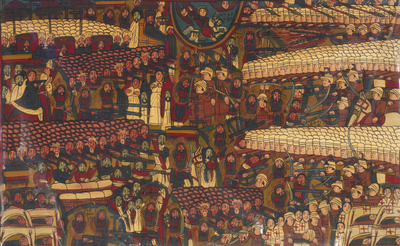Javascript must be enabled to continue!
painting (art)
View through Europeana Collections
The painting illustrates an interesting Ethiopian painting convention of depicting the 'good' full-faced and the 'bad' in profile only. In this painting the Ethiopians are always shown with all their facial features, but the Italians are only ever shown side-on.
The victory at Adwa was widely reported, strengthening Ethiopia’s image as defender of African independence. It became the source of pride and inspiration for Africans around the world. Today Ethiopians celebrate this historic victory with a national holiday on 2 March, the anniversary of the battle. Painting on cotton depicting the battle of Adwa. To the left are the massed armies of Ethiopia and to the right the Italian forces. In the centre of the painting, at the top, above the battle field, is Saint George, the patron saint of Ethiopia. The saint appears in a halo of red, gold and green, the colours of the Ethiopian flag. To the left of Saint George is the seated figure of Emperor Menelik. To the left of the Emperor is a large crowd of priests with white turbans, some carrying large crosses. Three priests carry holy tabots on their heads concealed beneath red cloths. Below, on horseback, is Empress Taytu with a revolver urging the Ethiopian troops to victory. The Italian forces are depicted as rows of pale-faced troops with white pith helmets.
Horniman Museum and Gardens
Title: painting (art)
Description:
The painting illustrates an interesting Ethiopian painting convention of depicting the 'good' full-faced and the 'bad' in profile only.
In this painting the Ethiopians are always shown with all their facial features, but the Italians are only ever shown side-on.
The victory at Adwa was widely reported, strengthening Ethiopia’s image as defender of African independence.
It became the source of pride and inspiration for Africans around the world.
Today Ethiopians celebrate this historic victory with a national holiday on 2 March, the anniversary of the battle.
Painting on cotton depicting the battle of Adwa.
To the left are the massed armies of Ethiopia and to the right the Italian forces.
In the centre of the painting, at the top, above the battle field, is Saint George, the patron saint of Ethiopia.
The saint appears in a halo of red, gold and green, the colours of the Ethiopian flag.
To the left of Saint George is the seated figure of Emperor Menelik.
To the left of the Emperor is a large crowd of priests with white turbans, some carrying large crosses.
Three priests carry holy tabots on their heads concealed beneath red cloths.
Below, on horseback, is Empress Taytu with a revolver urging the Ethiopian troops to victory.
The Italian forces are depicted as rows of pale-faced troops with white pith helmets.
Related Results
painting, painting, painting, painting, painting, painting, painting, painting, painting, painting, painting, painting, painting, painting, painting, painting, painting, painting, painting, painting, painting, painting, painting, painting, painting, paint
painting, painting, painting, painting, painting, painting, painting, painting, painting, painting, painting, painting, painting, painting, painting, painting, painting, painting, painting, painting, painting, painting, painting, painting, painting, paint
"Here is portrayed three Moods of the Sky and the effects on the Fish and Animals. Sharks and Turtles come to the Surface when it is Raining. Wallabies and Kangaroos are out feedin...
Luminescence
Luminescence
In 1925, at the first exhibition of the OST, the painter I. Kudriashov presented two series of paintings: the Construction of Straight Line Movement and the Construction of Curvili...
Heimdal överlämnar Brisingasmycket till Freja
Heimdal överlämnar Brisingasmycket till Freja
New acquisition, September 2013: Competition entry by Nils Andersson Nils Andersson's painting Heimdal Returns Brisingamen to Freya is an evocative example of the images of ancient...
Pierrot Content
Pierrot Content
Pierrot content is one of a group of early works by Watteau in which the artist developed the theme of the fête galante that would be so highly appreciated during the 18th century....
The Mother of God of Trakai
The Mother of God of Trakai
It is one of the oldest easel paintings in Lithuania, closely linked to Vytautas, the Grand Duke of Lithuania (reigning 1401-1430), and early Christianisation in Lithuania. Up unti...
Colors of Mount Emei (Emeishan se)
Colors of Mount Emei (Emeishan se)
Dong Shouping (1904-1997) painted this short hanging scroll in ink and colors on paper. It depicts Mt. Emei's famous and very colorful sunrise. A mass of rocks--presumably the moun...
The Water Stream, La Brème
The Water Stream, La Brème
“I also hold that painting is a quite concrete art, and can consist of nothing but the representation of real, tangible things, ” wrote Gustave Courbet in an open letter to his stu...




